The First National Bank Of North Baltimore
The First National Bank Of North Baltimore in Ohio printed $1,005,330 dollars worth of national currency. Over $1,000,000 face value is a lot of money. However, some types and denominations of currency from this bank could still be rare. This national bank opened in 1890 and stopped printing money in 1935, which equals a 46 year printing period. That is a fairly normal lifespan for a national bank. During its life, The First National Bank Of North Baltimore issued 9 different types and denominations of national currency. We have examples of the types listed below. Your bank note should look similar. Just the bank name will be different. For the record, The First National Bank Of North Baltimore was located in Wood County. It was assigned charter number 4347.
We buy all national currency. Please call or email us for a quote. Sales@AntiqueMoney.com
The First National Bank Of North Baltimore in Ohio printed 5,000 sheets of $5 1882 brown back national bank notes. A print range between 5,000 and 10,000 suggests that there should be at least a couple of notes known to exist. You can take the total number of sheets printed and multiply that number by four to get the exact number of 1882 $5 brown back bank notes this bank issued. Each note has a portrait of James Garfield on the left hand side of the bill. These are very popular with collectors because they have different text layouts. Some notes are worth as little as a few hundred dollars, but most are worth a good deal more.
Series of 1882 $5 Brown Back
The First National Bank Of North Baltimore printed 780 sheets of $50 1882 brown back national bank notes. Fifty dollar 1882 brown backs are few and far between. When the print number is under 1,000 like this bank then there is a great chance that you have a very rare bank note. The most common 1882 $50 brown backs are worth about $5,000. However, some can be worth more than $10,000 based on condition, serial number, and bank of issue.
Series of 1882 $50 Brown Back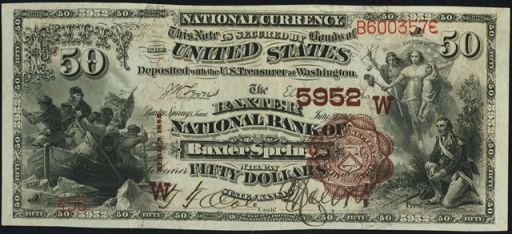
The First National Bank Of North Baltimore also printed 780 sheets of $100 1882 brown back national bank notes. High denomination $50 and $100 brown backs were printed on the same sheet. So the number of sheets printed also equals the number bills printed for each denomination. You can see that $100 brown backs are extremely scarce on this bank. We are very interested in purchasing $100 1882 brown back national bank notes. We have paid more than $15,000 for some examples. Send us pictures of what you have and we will respond quickly with an appraisal and offer.
Series of 1882 $100 Brown Back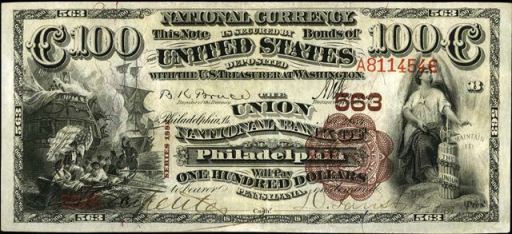
The First National Bank Of North Baltimore also printed 770 sheets of $5 1882 blue seal national bank notes. 1882 blue seals are traditionally not the most popular national bank notes. However, when we are talking about such a low print number, these become much more desirable. 1882 $5 blue seal bank notes were issued by some national banks in The United States. While these are a somewhat rarer issue, they just aren’t especially popular with collectors. With exception of some minor differences, they look exactly like the earlier brown back series. Most collectors would prefer the brown back notes. With that said, some 1882 blue seals can still be worth thousands of dollars. So don’t just assume that what you have is automatically common.
1882 Blue Seal $5 National Bank Note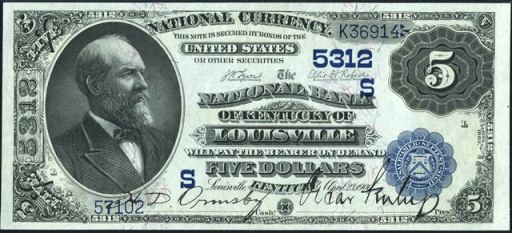
The First National Bank Of North Baltimore also printed 65 sheets of $50 1882 blue seal national bank notes. High denomination 1882 blue seals like this are not frequently encountered, regardless of the number of notes printed. There is a big difference between the two types of 1882 $50 blue seals. The variety that says “1882-1908” on the back is rare, but no where near as rare at the type that says “Fifty Dollars.” The second variety is extremely rare and only about a half dozen are known to exist. The first type should still be worth at least $4,000. The second type is a five figure rarity though.
1882 Blue Seal $50 National Bank Note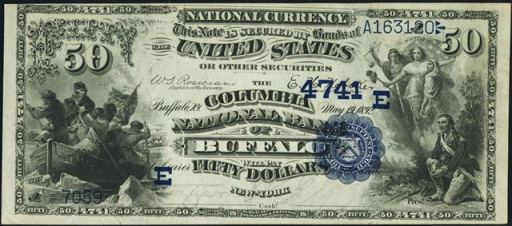
The First National Bank Of North Baltimore also printed 65 sheets of $100 1882 blue seal national bank notes. The number of sheets printed doesn’t matter too much here. All 1882 $100 blue seals are rare. They were issued by a total of 256 total national banks in the country. The rare 1882 value backs were only printed by banks in Dayton, Ohio and New Orleans, Louisiana. The slightly more common date backs are much more plentiful but still rare in the scheme of things.
1882 Blue Seal $100 National Bank Note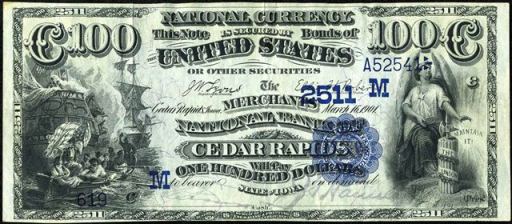
The First National Bank Of North Baltimore also printed 14,491 sheets of $10 1902 blue seal national bank notes. Once a bank prints more than 10,000 sheets of blue seals it becomes very difficult for those notes to be rare. 1902 $10 blue seal bank notes all have a portrait of William McKinley on them. Values can range from as little as $40 up to over $10,000. There really is no trick to know what is rare and what is common by just doing an internet search. You really need to work with an expert (like us) in order to determine the value of your specific bank note. There are at least ten different factors than can make some 1902 $10 blue seals worth more than others. We know exactly what to look for and we would be happy to provide a free appraisal and our best offer.
1902 $10 Blue Seal National Bank Note
The First National Bank Of North Baltimore also printed 2,514 sheets of Type1 1929 $10 national bank notes. That is a pretty typical sheet output for a national bank during the small size era. Each $10 bill from 1929 has a portrait of Alexander Hamilton on it. The black number written vertically is the charter number. The charter number never affects the value; it is just an identifier. The ten dollar type1 national bank note happens to be the single most common national bank note, with over 65,000 known to exist from all banks. Of course each note is valued based on its condition and rarity. Some are very rare.
Series of 1929 Type1 $10 National Bank Note
The First National Bank Of North Baltimore also printed 3,270 sheets of Type1 1929 $20 national bank notes. That is a pretty typical sheet output for a national bank during the small size era. Andrew Jackson is featured on the front of each 1929 $20 bill. Be sure to take note of the serial number on your specific bank note. If it is 000001 then you can expect a nice premium. There is a special market for serial number one bank notes. Of course, even if the number isn’t #1, it could still be collectible and have a high value just based on its condition and rarity alone.
Series of 1929 Type1 $20 National Bank Note



